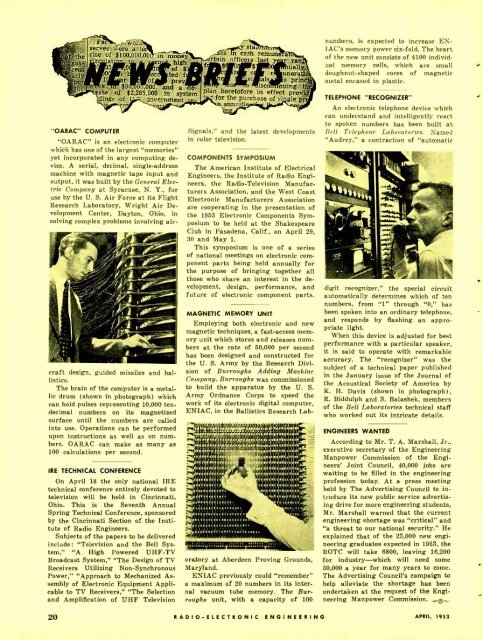T EVIS i - AmericanRadioHistory.Com
T EVIS i - AmericanRadioHistory.Com
T EVIS i - AmericanRadioHistory.Com
Create successful ePaper yourself
Turn your PDF publications into a flip-book with our unique Google optimized e-Paper software.
serves were a terise<br />
of $100,000,00<br />
circulati<br />
money<br />
high<br />
fct d i<br />
Ifypar of prey<br />
k $91.i0.000, and a<br />
ae of $2,265,000 in system<br />
dings of ' ^ government<br />
n<br />
"OARAC" COMPUTER<br />
"OARAC" is an electronic computer<br />
which has one of the largest "memories"<br />
yet incorporated in any computing device.<br />
A serial, decimal, single- address<br />
machine with magnetic tape input and<br />
output, it was built by the General Electric<br />
<strong>Com</strong>pany at Syracuse, N. Y., for<br />
use by the U. S. Air Force at its Flight<br />
Research Laboratory, Wright Air Development<br />
Center, Dayton, Ohio, in<br />
solving complex problems involving air-<br />
craft design, guided missiles and ballistics.<br />
The brain of the computer is a metallic<br />
drum (shown in photograph) which<br />
can hold pulses representing 10,000 ten -<br />
decimal numbers on its magnetized<br />
surface until the numbers are called<br />
into use. Operations can be performed<br />
upon instructions as well as on numbers.<br />
OARAC can make as many as<br />
100 calculations per second.<br />
IRE<br />
TECHNICAL CONFERENCE<br />
On April 18 the only national IRE<br />
technical conference entirely devoted to<br />
television will be held in Cincinnati,<br />
Ohio. This is the Seventh Annual<br />
Spring Technical Conference, sponsored<br />
by the Cincinnati Section of the Institute<br />
of Radio Engineers.<br />
Subjects of the papers to be delivered<br />
include: "Television and the Bell System,"<br />
"A High Powered UHF -TV<br />
Broadcast System," "The Design of TV<br />
Receivers Utilizing Non -Synchronous<br />
Power," "Approach to Mechanized Assembly<br />
of Electronic Equipment Applicable<br />
to TV Receivers," "The Selection<br />
and Amplification of UHF Television<br />
s ïash remun<br />
rtaih officers la<br />
HUll<br />
ran<br />
uauy.<br />
plan heretofore in effect pro<br />
- for the purchase of sigle<br />
pannuiti,<br />
Signals," and the latest developments<br />
in color television.<br />
COMPONENTS SYMPOSIUM<br />
The American Institute of Electrical<br />
Engineers, the Institute of Radio Engineers,<br />
the Radio -Television Manufacturers<br />
Association, and the West Coast<br />
Electronic Manufacturers Association<br />
are cooperating in the presentation of<br />
the 1953 Electronic <strong>Com</strong>ponents Symposium<br />
to be held at the Shakespeare<br />
Club in Pasadena, Calif., on April 29,<br />
30 and May 1.<br />
This symposium is one of a series<br />
of national meetings on electronic component<br />
parts being held annually for<br />
the purpose of bringing together all<br />
those who share an interest in the development,<br />
design, performance, and<br />
future of electronic component parts.<br />
MAGNETIC MEMORY UNIT<br />
Employing both electronic and new<br />
magnetic techniques, a fast -access memory<br />
unit which stores and releases numbers<br />
at the rate of 50,000 per second<br />
has been designed and constructed for<br />
the U. S. Army by the Research Division<br />
of Burroughs Adding Machine<br />
<strong>Com</strong>pany. Burroughs was commissioned<br />
to build the apparatus by the U. S.<br />
Army Ordnance Corps to speed the<br />
work of its electronic digital computer,<br />
ENIAC, in the Ballistics Research Lab-<br />
oratory at Aberdeen Proving Grounds,<br />
Maryland.<br />
ENIAC previously could "remember"<br />
a maximum of 20 numbers in its internal<br />
vacuum tube memory. The Burroughs<br />
unit, with a capacity of 100<br />
numbers, is expected to increase EN-<br />
IAC's memory power six -fold. The heart<br />
of the new unit consists of 4100 individual<br />
memory cells, which are small<br />
doughnut- shaped cores of magnetic<br />
metal encased in plastic.<br />
TELEPHONE "RECOGNIZER"<br />
An electronic telephone device which<br />
can understand and intelligently react<br />
to spoken numbers has been built at<br />
Bell Telephone Laboratories. Named<br />
"Audrey," a contraction of "automatic<br />
digit recognizer," the special circuit<br />
automatically determines which of ten<br />
numbers, from "1" through "0," has<br />
been spoken into an ordinary telephone,<br />
and responds by flashing an appropriate<br />
light.<br />
When this device is adjusted for best<br />
performance with a particular speaker,<br />
it is said to operate with remarkable<br />
accuracy. The "recognizer" was the<br />
subject of a technical paper published<br />
in the January issue of the Journal of<br />
the Acoustical Society of America by<br />
K. H. Davis (shown in photograph) ,<br />
R. Biddulph and S. Balashek, members<br />
of the Bell Laboratories technical staff<br />
who worked out its intricate details.<br />
ENGINEERS WANTED<br />
According to Mr. T. A. Marshall, Jr.,<br />
executive secretary of the Engineering<br />
Manpower <strong>Com</strong>mission of the Engineers'<br />
Joint Council, 40,000 jobs are<br />
waiting to be filled in the engineering<br />
profession today. At a press meeting<br />
held by The Advertising Council to introduce<br />
its new public service advertising<br />
drive for more engineering students,<br />
Mr. Marshall warned that the current<br />
engineering shortage was "critical" and<br />
"a threat to our national security." He<br />
explained that of the 23,000 new engineering<br />
graduates expected in 1953, the<br />
ROTC will take 6800, leaving 16,200<br />
some<br />
for industry -which will need<br />
30,000 a year for many years to come.<br />
The Advertising Council's campaign to<br />
help alleviate the shortage has been<br />
undertaken at the request of the Engineering<br />
Manpower <strong>Com</strong>mission. b 8 e<br />
20<br />
RADIO -ELECTRONIC ENGINEERIN<br />
G APRIL, 1953

















